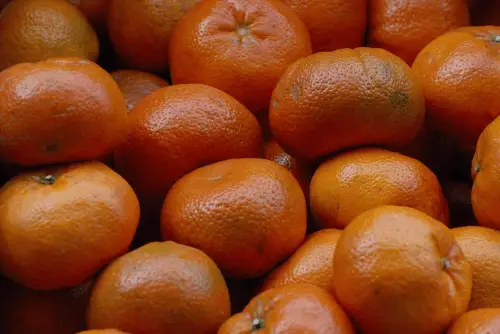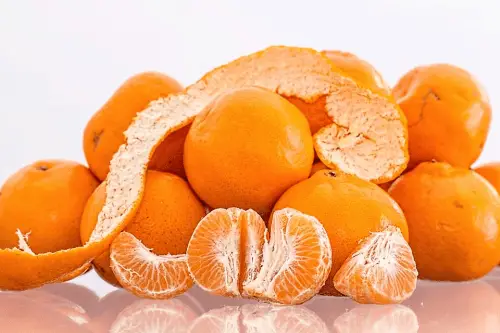Is it all the same to you when you eat an orange, a tangerine, or a mandarin? Some people simply divide these fruit into “oranges” and “smaller oranges” as categories and leave it as such. But if you are still interested in what you eat and wish to find out the difference between a tangerine and a mandarin, read on.
Summary Table
| Tangerine | Mandarin |
| All tangerines are mandarins | Mandarins are a type of citrus fruit including tangerines, clementines, and satsumas |
| Were first introduced to Europe through Tangiers | Come from South-east China |
| Round in shape | Oblate in shape, flat at both ends |
| Has a reddish-orange color | Is bright orange |
| Has a thick skin with a pebbly aspect | Has a smooth and thin skin that is very easily peeled |
| Is a bit tart | Is sweet |
| Can be cooked with duck and chicken | Goes well with salads and desserts |
Definitions

A tangerine is a citrus fruit. According to some classifications, it is a type of mandarin, while according to others, it is a separate species in itself. Its peel is reddish-orange in color and is tough. As far as taste is concerned, the tangerine is a bit tart.
Tangerines tend to be smaller than mandarins. These are seedless fruits, which means you won’t have to worry about removing the seeds before you enjoy a tangerine. Today, tangerines are mostly grown in the southern parts of the US.

A mandarin is a group of citrus fruit which includes tangerines, clementines, and satsumas. Appearance-wise, the mandarin has a bright orange peel that is smooth and thin. Its pulp is very sweet and juicy.
Mandarins generally have flat tops with wide bodies. They’re about 1.5 to 3 inches around. Mandarins are grown in tropical and subtropical areas; they do not do well in colder temperatures or climates.
The Origin of Tangerines and Mandarins
The mandarin has a long history. Both fruits were developed in southern Asia and the Philippines. They were considered symbols of good fortune; however, they didn’t come to the US until after the middle of the 19th century.
Tangerines are a hybrid of mandarins. This fruit traveled on the Silk Road (an ancient trade route), where it was taken to other parts of the world outside of Asia. When the fruit came to Tangiers (in Morocco), it was named “tangerine.”
The good news is that both the mandarin and the tangerine are considered to bring good fortune, happiness, and prosperity.
Tangerine vs Mandarin
Apart from it being a matter of personal taste and preference, knowing the difference between a tangerine and a mandarin is important, especially if you cook a lot of international recipes.
The relationship between the two
A tangerine is a type of mandarin, but not all mandarins are tangerines. Apart from tangerines, other types of mandarin oranges are clementines and satsumas.
Names
Although they were both cultivated in South-east China, tangerines first arrived in Europe through Tangier, hence the name “tangerines.” Otherwise, mandarins, as a group of fruit, are originally from China, as one might expect.
Appearance
As far as shape is concerned, a mandarin is more oblate, while a tangerine is rounder. You can more easily stack mandarins in a pile, as they are flat at both ends.
The color of a mandarin is light orange, whereas a tangerine has a slightly reddish-orange hue. Put side by side, you notice that the tangerine is visibly darker than other types of mandarins.
A tangerine has a thicker skin with a pebbly aspect. On the other hand, a mandarin is smoother and has a thinner skin. It is always easier to peel a mandarin than any other citrus fruit. This also makes it softer and more sensitive to bruising.
Taste and kitchen use
There is a difference in taste between tangerines and other types of mandarins in the sense that a tangerine is somewhat tart, while the others are sweeter. This makes tangerines perfect for cooking with meats such as duck and chicken. Mandarins are great for salads and desserts.
Particular traits
Tangerines are the ones most often associated with the notion of the Christmas orange and they are great to consume when you have a cold. They contain synephrine, which is a decongestant. Although they are easily transported, they do not keep well without refrigeration.
Nutrition
Tangerines and mandarins are both healthy fruits and contain plenty of nutrients.
Tangerines
- 53 kcal
- 13.3 grams carbohydrates
- 9.2 grams sugars
- 1.8 grams dietary fiber
- 0.8 grams protein
- 0.3 grams fat
- Vitamin C: 26.7 mg
- Vitamin A: 681 IU
- Folate (Vitamin B9): 16 mcg
- Potassium: 166 mg
- Calcium: 37 mg
- Magnesium: 12 mg
Mandarins:
- 53 kcal
- 13.3 grams carbohydrates
- 10.6 grams sugars
- 1.8 grams dietary fiber
- 0.8 grams protein
- 0.3 grams fat
- Vitamin C: 26.7 mg
- Vitamin A: 681 IU
- Folate (Vitamin B9): 16 mcg
- Potassium: 166 mg
- Calcium: 37 mg
- Magnesium: 12 mg
As you can see, tangerines and mandarins are comparable when it comes to how healthy they are and the nutrients they offer!
Both of these fruits help with the following:
- Boost immune system
- Absorb iron and increase energy
- Support brain health
- Stabilize blood pressure
- Promote healthy skin
- Fight cell damage
- Reduce inflammation
- Support a healthy digestive tract





